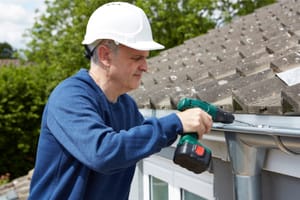Dry rot can be a serious concern for homeowners and property managers, causing significant structural damage if not addressed timely.
Despite its impact, there's a lot of misinformation surrounding dry rot repair, leading to unnecessary stress and costly decisions.
Understanding the truth behind common myths about dry rot can empower you to take effective action and protect your property.
Explore the facts and uncover essential insights to manage dry rot issues confidently with our comprehensive guide below.
1)) Dry Rot Only Occurs In Old Buildings
One of the most pervasive myths about dry rot is that it only affects old buildings.
In reality, dry rot can impact any structure, regardless of its age, if the conditions for its development are present.
Dry rot thrives in environments with high moisture levels, making any building susceptible, whether constructed last year or a century ago.
Poor ventilation, leaks, or inadequate maintenance can create perfect conditions for dry rot, undermining the integrity of even the newest establishments.
Recognizing that age is not a determinant for dry rot is crucial for comprehensive property care, ensuring that no building is falsely presumed immune to its effects because of its recent construction date.
Understanding this reality prompts all homeowners to remain vigilant in monitoring and maintaining their property to prevent potential damages.
2)) Painting Over Dry Rot Will Stop The Damage
Some people mistakenly believe that painting over dry rot can halt its progression and restore affected areas.
However, painting is merely a cosmetic fix that fails to address the underlying issue of fungal growth and moisture.
The paint acts as a surface barrier but does nothing to eliminate the conditions that foster dry rot, such as dampness and poor ventilation.
Without treating the source, the fungus will continue to spread beneath the paint, leading to further structural damage.
Effective remediation requires removing the affected wood and correcting moisture issues, ensuring that the rot is thoroughly eradicated.
By recognizing the limitations of painting, homeowners can avoid superficial solutions and focus on comprehensive repairs to safeguard their property.
3)) Only Wood Can Be Affected By Dry Rot
Believing that dry rot only affects wood is another common misconception.
While wood is indeed the primary material vulnerable to dry rot due to its organic nature, it is not the only casualty of this insidious decay.
Dry rot can cause indirect damage to other materials and components of a structure, including plaster, brick, and metal fasteners, due to the structural compromise it causes in wooden elements.
The fungus travels through porous materials and spreads its impact, potentially leading to issues like weakened load-bearing walls or compromised structural supports.
Therefore, addressing dry rot requires a holistic approach, considering all materials within the vicinity of affected wood to prevent further deterioration.
Acknowledging this broader scope encourages a more thorough inspection and effective repair strategy, protecting the overall integrity of the entire building.
4)) Dry Rot Is Purely A Cosmetic Issue
Assuming that dry rot is merely a cosmetic issue and overlooking its potential risks can lead to severe consequences.
While the initial appearance of dry rot might seem superficial, the underlying damage it causes to the structural integrity of a building is far from just aesthetic.
The fungus responsible for dry rot not only weakens wood, but it also compromises the stability of key structural components, leading to significant safety hazards.
Addressing dry rot as a cosmetic deficiency results in neglecting the necessary repairs required to eliminate the root cause.
Proactively treating dry rot as a structural concern will ensure lasting repairs and protect the longevity of a property, emphasizing its critical impact on both safety and durability.
Distinguishing the true nature of dry rot emphasizes the urgency of addressing it beyond surface-level solutions.
5)) It’s Easy To Detect Dry Rot Early
Identifying dry rot at its onset is often more difficult than many believe. Early stages of dry rot do not always present visible signs, making detection challenging without a thorough inspection.
The initial indicators, such as a musty odor or minor discoloration, can easily be overlooked or attributed to less severe issues.
Dry rot thrives in hidden areas away from direct view, such as under floors, behind walls, or in poorly ventilated spaces, further complicating early detection efforts.
Relying solely on visual cues can lead to a false sense of security, allowing the rot to progress unnoticed until it causes significant damage.
Awareness of the potential for dry rot's subtle beginnings is crucial, driving the need for regular inspections and professional evaluations to uncover hidden threats.
By acknowledging the difficulty in detecting dry rot early, property owners can take proactive steps to prevent unseen decay and protect their investments effectively.
6)) You Can Treat Dry Rot With Household Products
Believing that dry rot can be effectively treated with household products is another myth that can lead to inadequate repair efforts.
Household remedies, such as vinegar or bleach, might seem like convenient solutions but fail to address the extent of fungal infestations and moisture issues associated with dry rot.
Since dry rot is caused by a specific type of fungus that penetrates deep into wooden structures, simply applying surface treatments with common household items will not eradicate the problem.
Comprehensive treatment involves removing infected wood, drying out affected areas, and applying specialized fungicidal treatments to prevent recurrence.
By relying on professional methods instead of DIY shortcuts, homeowners can ensure thorough and lasting eradication of dry rot, preventing further damage and maintaining the structural integrity of their property.
Understanding the limitations of household products encourages seeking expert solutions for effective remediation and long-term property preservation.
7)) Once Treated, Dry Rot Will Not Reoccur
Assuming that dry rot will not return after initial treatment overlooks the persistent conditions that allow the fungus to thrive.
Although addressing dry rot with appropriate treatment can eliminate existing infections, it does not safeguard against future outbreaks if the underlying issues remain unresolved.
Factors such as moisture, inadequate ventilation, and minor leaks create conducive environments for dry rot to reemerge.
Without permanently addressing these environmental conditions, treated areas remain vulnerable to renewed fungal activity.
Thus, comprehensive treatment must include identifying and mitigating the sources of moisture and ensuring adequate ventilation to prevent recurrence.
Emphasizing the importance of ongoing vigilance and environmental management is crucial to maintaining a dry rot-free property, highlighting the need for preventative measures to secure long-term success in combating this persistent challenge.
8)) Dry Rot Is Not A Serious Structural Problem
Dismissing dry rot as an insignificant structural issue can lead to alarmingly dangerous outcomes.
While it may initially appear less threatening due to its sometimes inconspicuous nature, dry rot significantly undermines the strength and stability of wooden structures, posing serious safety risks.
The fungus responsible for dry rot gradually deteriorates wood fibers, causing them to lose their cohesive strength, which can result in structural components failing unexpectedly.
This degradation is not limited to wooden beams but extends to any area where wood serves a vital structural role, amplifying the potential for catastrophic damage if ignored.
Therefore, treating dry rot with the seriousness it deserves and comprehensively addressing it with accurate remediation highlights its critical impact on building safety.
The misconception of dry rot as a minor issue underscores the importance of treating it with appropriate urgency to prevent severe structural failures that could jeopardize property and occupant safety.
Conclusion
The numerous misconceptions surrounding dry rot highlight the critical need for proactive measures and informed decision-making.
Recognizing the complex nature of dry rot and the environmental conditions that contribute to its occurrence is the first step in effective prevention and management.
By prioritizing early identification, comprehensive treatment, and addressing underlying factors such as moisture and ventilation, property owners can safeguard their investments against potential decay and structural damage.
Dismissing dry rot as a minor problem not only jeopardizes the integrity of the structure but also poses significant safety risks.
Prioritizing educated approaches and professional interventions ensures long-term stability and protection of property, reinforcing the importance of addressing dry rot with appropriate urgency and care.
Download Our Free E-book!








